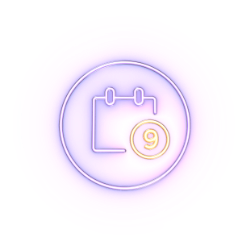
TARPEYO is a convenient, once-daily oral course of therapy1TARPEYO is not an injection
Defined 9-month course may provide flexibility for some patients

DOSE
Recommended dose: 16 mg/day (4 capsules)

DURATION & DISCONTINUATION
Recommended duration of therapy: 9 months
When treatment is discontinued, dose should be reduced to 8 mg/day (2 capsules) for the last 2 weeks of therapy

TIMING
TARPEYO should be swallowed
whole in the morning, at least 1 hour before a meal

CAPSULE
Capsules should be swallowed whole.
Do NOT open, crush, or chew capsules

MISSED DOSE
If a dose is missed, the prescribed dose should be taken at the next scheduled time. Do NOT double the next dose
Safety and efficacy of treatment with subsequent courses of TARPEYO have not been established.

Complete the recommended full course to help optimize treatment outcomes1

Assess response at 6 months or after1
Evaluate therapy response at 6 months or after as patients start to see reductions in proteinuria during this time

Complete the recommended 9-month course of treatment1
UPCR reductions at months 6, 9, and 12 support completing the full 9-month treatment course

Set expectations around the potential for side effects1-3
Most adverse reactions were mild or moderate and resolved within 3 months of completing therapy*
- Discontinuation rates were low: <10% of patients treated with TARPEYO + RASi discontinued due to TEAEs (9% vs 2%)*
- The most common adverse reactions occurring in ≥10% of patients treated with TARPEYO + RASi and at a higher incidence than RASi alone were: peripheral edema, hypertension, muscle spasms, acne, and headache
- Incidence of TESAEs with TARPEYO + RASi vs RASi alone was 9% vs 5%*
Proactively setting expectations is important for supporting adherence to therapy
*Safety updated based on NeflgArd Safety Analysis Set, which included data from all patients who received ≥1 dose of study drug. In the global study, an additional 29 patients were enrolled in China for regulatory requirements after global recruitment had ended. ADRs or ARs were reported in the placebo-controlled, 9-month treatment period until 14 days after completion of the tapering period.1,2
ADR=adverse drug reaction; AR=adverse reaction; KDIGO=Kidney Disease: Improving Global Outcomes; RASi=renin-angiotensin system inhibitor; TEAE=treatment-emergent adverse event; TESAE=treatment-emergent serious adverse event; UPCR=urine protein-to-creatinine ratio.
REFERENCES: 1. TARPEYO. Prescribing Information. Calliditas Therapeutics AB; June 2024. 2. Data on file. Calliditas Therapeutics AB. 3. World Health Organization. Adherence to long-term therapies: evidence for action. Accessed October 30, 2025. https://apps.who.int/iris/bitstream/handle/10665/42682/9241545992.pdf







